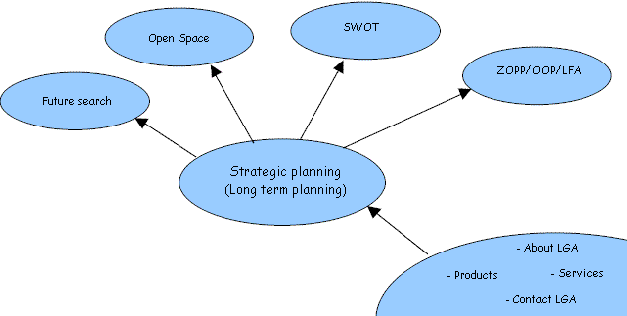 |
|
Strategic Planning - Long Term Planning (Click the icon on the left to return to the top level diagram) |
Strategic Planning - What and Why What - Strategic, or long term planning, is an attempt to shape the future. This implies that some "picture" or vision of the desired future is has to be formulated. Strategic planning therefore starts by seeking to define this vision. The current approach to strategic planning makes the assumption that it will be a collaborative process, rather than one person deciding what the vision and goals should be. The strategic plan will define a small number, usually less that ten, of strategic objectives which, if they are met will result in achieving the goal of the group or organization. See also strategic planning approaches, and strategic planning process. Why - Organizations plan strategically with a number of expectations for example:
Strategic Planning - Approaches A number of different approaches are in use to define the strategic objectives, some of the more well know ones are:
All these processes have some principles in common:
The approaches differ in several ways and each has its' strengths and weaknesses. For example, the focus on "present problems" and "problem analysis found in the ZOPP/OOPP/LFA approach can lead to groups getting "bogged down" in the negative feelings of persistent problems or in trying to apportion blame for the problems to a particular part of the organization. This is often not conducive to resolving the situation. However, there are occasions where it is vital to identify the cause of a problem if a cure for that problem is to be found. In practice, combinations of these approaches may be used. For example, the initial step might be a future search conference to define the strategic objectives. The second step might be to use part of the LFA approach to examine alternative strategies to achieve those objectives and to produce the detailed plans and to test their validity. Future search is a structured planning meeting that makes possible actions once thought beyond reach in large, divers groups. These include projects and programs based on new forms of cooperation devised by participants. This approach is popular in non-business communities. In Future search the emphasis is to "leap forward" in time to identify the desired future condition and work back to find ways to reach that situation. Open space was a precursor to Future search. It is far less structured than most other methods. There is no preset agenda other than the topic previously agreed to and the time allotted to the meeting. There are no planned panel discussions and no plenary sessions. The agenda is created through the facilitator inviting everyone present to nominate issues that he or she feels strongly about and is prepared to take responsibility for. SWOT (Strengths, Weaknesses, Opportunities and Threats) This approach is popular in business environments. It seeks to identify what the organization is currently doing well (strengths), what it is not doing well (weaknesses), what market conditions can be exploited to advantage (opportunities) and what factors, internal and external can derail the organization's efforts (threats). ZOPP/OOPP/Logical Framework Approach The Logical Framework Approach (LFA), also referred to as Objectives Oriented Project Planning (OOPP) and in German as Ziel Orientierte Projek Planung (ZOPP) is a structured meeting process. This approach seeks to identify the major current problems using cause-effect analysis and search for the best strategy to alleviate those identified problems. This topic is dealt with in more detail on the main page: Logical Framework Approach The planning process is the sequence of steps the planning group go through to produce the plan. For example:
The essential features of a process are:
|